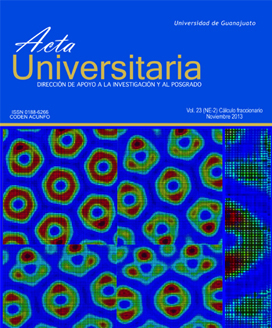Published 2013-12-01
Keywords
- Helmholtz oscillator,
- Fractional damping,
- Grünwald-Letnikov fractional derivative.
- Oscilador Helmholtz,
- amortiguación fraccionaria,
- derivada fraccionaria Grünwald-Letnikov.
How to Cite
Abstract
The dynamics of the nonlinear Helmholtz Oscillator with fractional order damping are studied in detail. The discretization of differential equations according to the Grünwald-Letnikov fractional derivative definition in order to get numerical simulations is reported. Comparison between solutions obtained through a fourth-order Runge-Kutta method and the fractional damping system are comparable when the fractional derivative of the damping term a is fixed at 1. That proves the good performance of the numerical scheme. The effect of taking the fractional derivative on the system dynamics is investigated using phase diagrams varying a from 0.5 to 1.75 with zero initial conditions. Periodic motions of the system are obtained at certain ranges of the damping term. On the other hand, escape of the trajectories from a potential well result at a certain critical value of the fractional derivative. The history of the displacement as a function of time is shown also for every a selected.

